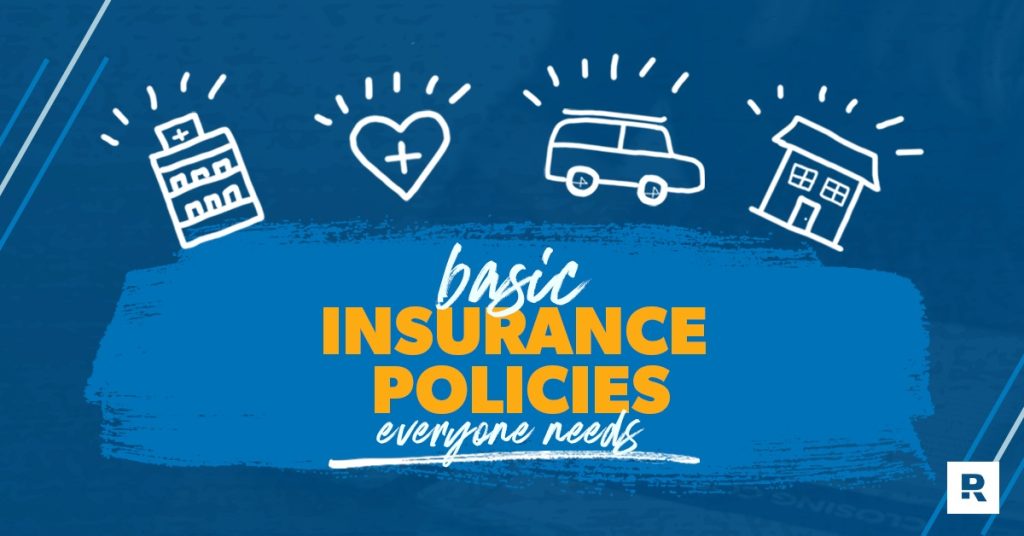If insurance has you scratching your head, maybe even pulling out your hair (don’t do that), you’re not alone. The world of insurance is complicated, tricky, confusing—all the adjectives. But don’t sweat it. We’ll strip down this sticky subject to the bare bones so you can actually understand what you need.
Let’s jump in!
Basic Terms and Definitions
Everyone needs some kind of insurance. It’s a crucial part of your defensive strategy since it protects your finances from all the bad (and expensive) things that can come up. And whether you’re just striking out on your own after finishing college or you’re married with kids, a dog and a house with a white picket fence, insurance gives you peace of mind knowing you’re covered.
You can get insurance to cover your car, home, apartment, condo, business, pet, health and more. (And if you really want to dig into the places you might have insurance gaps, check out our free five-minute Coverage Checkup.)
Before we unpack the basic insurance policies everyone should know about, let’s knock out some Merriam-Webster stuff first:
Premium: The insurance premium is the amount of money you pay an insurance company (usually monthly) to keep your insurance active.
Deductible: Your deductible is the amount of money you have to pay out of pocket before your insurance company pitches in. For example, let’s say your car insurance has a $1,000 deductible and you get into a car accident that causes $2,000 worth of damage to your car. You’ll have to pay $1,000 toward the repair before your insurance will cover the rest.Pro tip: You can generally pay a lower premium by getting a higher-than-normal deductible. (But do this only if you have a solid emergency fund in place.)
Copay/copayment: A copay has to do with health insurance and is the amount you pay every time you need a specific type of service—like a doctor’s visit. Usually, your copayments don’t count toward your deductible.
Liability: This is the part of your insurance that covers other people’s costs if you’re at fault for an incident that caused them injury or damage to their property. Let’s say you’re renting an apartment and you accidentally start a kitchen fire that destroys your neighbor’s property (okay, who set the microwave for 20 minutes?). It would be up to you to replace their stuff (not your landlord). But you’d be covered with a renters insurance policy that has $500,000 in liability. You’re almost always required to get this if you drive a car as well.
Declarations page: The declarations page is your formal proof of insurance. Also called a certificate of insurance, this document contains information such as effective dates of the policy, premium and deductible amounts, liability limits and the amount of coverage.
Claim: A claim is the request you make to the insurer for payment or reimbursement after an incident. To file a claim, you’ll have to provide information about yourself, details about the incident and personal contacts of everyone involved. Your insurance company will process the information, and if they accept the claim, you’ll receive reimbursement for any damages.
Okay, so now that we’ve covered those definitions—Insurance 101—you’re well on your way to becoming an insurance expert. Let’s dig into Insurance 202: the basic types of insurance.
Car Insurance for Beginners
One of the most popular types of insurance is car insurance. This is partly because it’s required by law, so you really don’t have a choice on this one. The average auto insurance premium is about $1,529 a year for full coverage, which is about $127 per month.1,2 But premiums vary based on your deductible, your age, the make and age of your car, your driving history, the state you live in, and the type of insurance you purchase.
Do you have the right insurance coverage? You could be saving hundreds! Connect with an insurance pro today!
You should choose your type based on how much car insurance you need. The three most basic types of auto insurance are liability, comprehensive and collision coverage.
Liability
Auto insurance liability covers another person’s expenses if an incident is your fault. You should choose at least $500,000 worth of liability coverage for property damage and bodily injury to save yourself from bankruptcy in the case of an accident.
Your coverage limits may look a little confusing when they show up on your insurance statement as $250,000/$500,000/$250,000 or 250/500/250. When you see this, it simply means:
- $250,000 of coverage for bodily injury (per person)
- $500,000 of coverage for bodily injury (per accident)
- $250,000 of coverage for property damage (per accident)
Comprehensive
Comprehensive coverage kicks in to repair or replace your car if it gets stolen or damaged by a fire, storm, falling tree branches or other natural disasters.
Collision
Collision coverage repairs or replaces your car if you’re in an accident with another vehicle, object or even yourself—no matter who’s at fault. Keep in mind that someone else’s liability coverage will only cover your expenses if the other driver is at fault. And that’s only if they have enough liability insurance to cover you.
Renters and Homeowners Insurance for Beginners
If you’re renting an apartment or house, renters insurance covers your stuff in the case of a fire or theft. Many people (mistakenly) assume their landlord’s insurance will cover their belongings. It won’t. A landlord’s insurance will only pay to rebuild what belongs to them—the building.
Bottom line? Don’t go without renters insurance. Plus, it’s super cheap! Renters insurance only costs around $15 per month or $180 per year on average.3
So, what if you own a home? Well, then you need homeowners insurance—and you should have enough to cover the replacement of your home and belongings. The average homeowners insurance annual premium is $1,249 or about $104 a month.4
Renters and homeowners insurance usually provide these three types of coverage:
- Personal property covers the cost to repair or replace items including electronics, clothing, furniture, etc.
- Liability covers repairs if you accidentally damage another person’s property or covers medical bills if you’re at fault for their injuries.
- Additional living expenses covers costs if you’re at fault for damage that makes the space unlivable.
And here’s another pro tip: Before you buy renters or homeowners insurance, check with an agent to see if you can save money by bundling it with your car insurance. One of the independent insurance agents who’s part of our Endorsed Local Providers (ELPs) program can help you check your policies to see if you could save.
Health Insurance for Beginners
Everyone needs health insurance. Even if you think you’re healthy and fit, medical emergencies can happen out of nowhere and send your finances spiraling out of control. The average American pays $452 per month for marketplace health insurance.5
While that might seem high, it pales in comparison to the many thousands of dollars a medical emergency could cost you. To give you an idea of what this could look like, healthcare.gov claims that the average cost of a three-day hospital stay is around $30,000.6
Using a Health Savings Account (HSA) can be a great way to save money on health insurance if it’s available to you. An HSA is a savings account dedicated to health care costs. It allows you to contribute and withdraw money tax-free and qualifies you for a tax deduction! You can use the money to pay for all qualifying medical expenses, from Band-Aids to doctor bills. And if you don’t spend all your HSA funds, you can carry them over from year to year and even invest them so they grow over the long term! HSAs work best for folks who are generally healthy, because the accounts are combined with high-deductible health plans that usually have lower monthly premiums.
Term Life Insurance for Beginners
Term life insurance is another basic insurance policy you should know about. The purpose of life insurance is to replace your income when you die. But why should you care about replacing your income in the first place? Well, if you have a family that depends on your income, they’ll lose it after you’re gone. If you’re single, you’ll need at least a basic amount to cover your burial costs or any remaining debts so the burden doesn’t fall on your family.
Life insurance prevents financial chaos from adding to your loved ones’ grief after you die. Since the goal is to replace your income, you should get coverage equal to 10–12 times your income.
One final note on life insurance: Never get whole life (also known as cash value insurance). It’s a complete rip-off. If you compare term life and whole life insurance, you’ll find that whole life has a more expensive monthly price tag for a much smaller payout.
What About Warranties?
Don’t waste money on insurance for phones, tablets, technology, etc. You can cover the cost of replacing or repairing smaller items that offer warranties by practicing what we teach and having an emergency fund.
But what about items like fine jewelry and engagement rings? While covering your engagement ring can be smart, jewelry can often be included in your renters and homeowners insurance.
Do You Have the Right Insurance?
Take the coverage checkup to find out what insurance coverage you should add, tweak, or drop based on your individual needs.
Get the Right Insurance
This was just a quick breakdown of how insurance works, but now you should be a whole lot more prepared to get the right coverage. And if you’re looking for help figuring out exactly what you need, our Endorsed Local Providers (ELPs) can check your situation and shop for you. And they’re RamseyTrusted, so you’ll be working with agents who are some of the best in the business.
Connect with an ELP today!
Read the full article here










